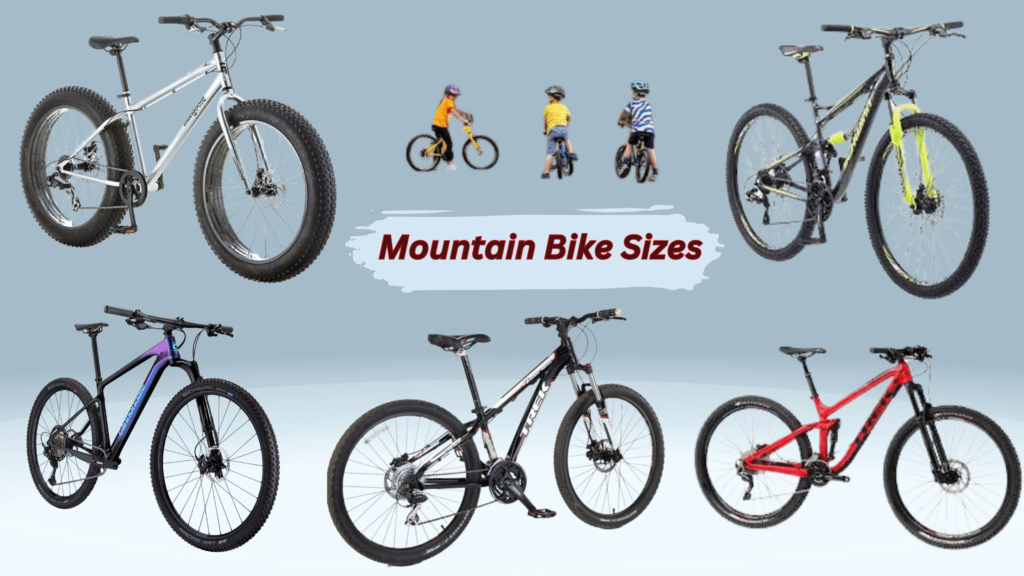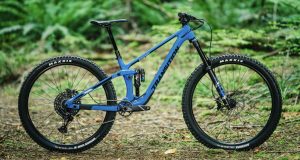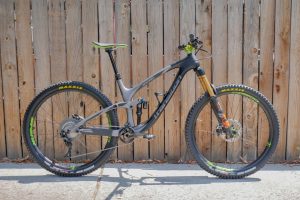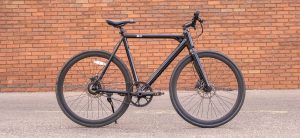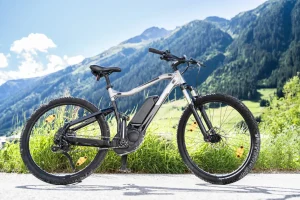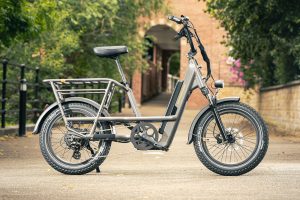Let me discuss how to measure mountain bike size for women, men, and kids and provide you with a comprehensive guide to help you find the perfect bike. Whether you are a seasoned rider or just starting out, finding a mountain bike that fits you properly to ensure maximum comfort, control, and safety is essential.
Why is Proper Mountain Bike Sizing Important?
Proper mountain bike sizing is crucial for several reasons, including comfort, control, and safety. A poorly fitting bike can cause discomfort, pain, and even injury, while a properly fitting bike allows you to ride longer, more comfortably, and with greater control. Moreover, the right mountain bike size ensures proper weight distribution, contributing to better handling and stability on rough terrain.

Understanding Bike Geometry
Before measure mountain bike size, it is essential to understand the basic bike geometry. Bike geometry refers to the relationship between the frame, wheels, handlebars, and saddle. It affects how the bike handles, its stability, and its comfort.
The primary bike geometry factors to consider include the frame size, standover height, reach, stack, and head angle.
The standover height is the distance between the top of the frame and the ground, whereas the frame size relates to the length of the seat tube.
The distance between the saddle and the handlebars is referred to as the reach, while the distance between the center of the bottom bracket and the top of the head tube is referred to as the stack. The head angle refers to the angle between the head tube and the ground.
Types of Mountain Bikes
Mountain bikes come in various types, each designed for a specific type of terrain and riding style. The main types of mountain bikes include cross-country, trail, all-mountain, enduro, downhill, and fat bikes. Each type has a different frame geometry, suspension, and wheel size, so choosing the right bike for your needs is essential.
Measuring Mountain Bike Size
To measure mountain bike size, you need to take several measurements, including inseam, height, and arm length.

Inseam Measurement
The inseam measurement is the most critical measurement when it comes to bike sizing. To measure your inseam, stand with your back against a wall, and place a book or a level between your legs, pulling it up to your crotch. Measure the distance between the top of the book or level and the ground.
Height Measurement
The height measurement is another crucial factor in mountain bike sizing. Stand up straight without shoes against a wall, and measure the distance between the top of your head and the ground.
Arm Length Measurement
To measure your arm length, stand with your back against a wall and stretch out your arms to the side, parallel to the ground. Measure the distance between your fingertips.
Mountain Bike Size Charts

Mountain bike size charts can be helpful in determining the right size bike for your needs. Most manufacturers provide sizing charts based on your height, inseam, and arm length, so it is essential to refer to the size chart that matches the type of mountain bike you want to purchase. It is important to note that mountain bike sizes can vary between manufacturers and models, so it is always best to try out the bike before purchasing it.
Mountain Bike Size Chart for Women
The following chart provides a general guideline for mountain bike size for women based on height:
| Height (in) | Height (cm) | Bike Size |
| 4’10”-5’2″ | 147-157 | XS |
| 5’2″-5’6″ | 157-168 | S |
| 5’6″-5’10” | 168-178 | M |
| 5’10”-6’1″ | 178-185 | L |
| 6’1″-6’4″ | 185-193 | XL |

It’s crucial to keep in mind that this is only a general recommendation, and there can be differences depending on things like body proportions and riding style. You should also refer to the manufacturer’s size chart for the specific bike model you are interested in.
How to Choose the Right Mountain Bike Size for Women
When choosing a mountain bike size for women, there are several factors to consider:
- Height: Your height is the primary factor in determining the bike size you need. Use the mountain bike size chart for women above as a general guideline.
- Inseam length: Besides height, the inseam length is an important factor. Stand with your back against a wall to measure your inseam length and place a book between your legs as high as possible. This measurement can help you determine the appropriate frame size for your body.
- Riding style: The riding you plan to do can also affect the size of bike you need. For example, if you plan to do more technical riding, you may want a smaller bike size for better maneuverability.
- Frame geometry: Mountain bike frames can have different geometries that affect the fit of the bike. Women-specific frames often have shorter top tubes, narrower handlebars, and more standover clearance to accommodate women’s body proportions.
- Test ride: Once you have narrowed down your options, it’s important to test ride the bikes to ensure the right fit.
Conclusion
Choosing the right mountain bike size for women is important for women to have a comfortable and safe ride. You can choose the right bike size by considering factors such as height, inseam length, riding style, and frame geometry. Always refer to the manufacturer’s size chart and test-ride the bike to ensure a proper fit. With the right size, you can enjoy the thrill and adventure of mountain biking to the fullest. (mountain bike size for women)
Mountain Bike Size Chart for Men

The following chart provides a general guideline for mountain bike size for men based on height:
| Height (in) | Height (cm) | Bike Size |
| 5’2″-5’6″ | 157-168 | XS |
| 5’6″-5’9″ | 168-175 | S |
| 5’9″-6’0″ | 175-183 | M |
| 6’0″-6’3″ | 183-191 | L |
| 6’3″-6’6″ | 191-198 | XL |
How to Choose the Right Mountain Bike Size for Men
Choosing the right mountain bike size for men involves considering a few factors:
- Height: Your height is the primary factor in determining the bike size you need. Use the mountain bike size chart for men above as a general guideline.
- Inseam length: In addition to height, inseam length is also an important factor to consider. Stand with your back against a wall and place a book between your legs as high as possible. This measurement can help you determine the appropriate frame size for your body.
- Riding style: The riding you plan to do can also affect the size of bike you need. For example, if you plan to do more technical riding, you may want a smaller bike size for better maneuverability.
- Frame geometry: Mountain bike frames can have different geometries that affect the fit of the bike. Pay attention to the top tube length, head tube angle, and seat tube angle to ensure a comfortable fit.
- Test ride: Once you have narrowed down your options, it’s important to test ride the bikes to ensure the right fit.
Conclusion
Choosing the right mountain bike size for men is essential for men to have a comfortable and enjoyable ride. Consider factors such as height, inseam length, riding style, and frame geometry to choose the right size. Always refer to the manufacturer’s size chart and test ride the bike to ensure a proper fit. With the right size bike, you can enjoy the thrills of mountain biking while staying safe and in control.
Mountain Bike Size Chart for Kids

The following chart provides a general guideline for mountain bike sizes for kids based on age and height:
| Age | Height (in) | Height (cm) | Bike Size |
| 2-4 | 2’10”-3’4″ | 86-102 | 10″ |
| 4-6 | 3’4″-3’8″ | 102-112 | 12″ |
| 5-8 | 3’8″-4’2″ | 112-127 | 16″ |
| 7-10 | 4’2″-4’10” | 127-147 | 20″ |
| 9-12 | 4’10”-5’3″ | 147-160 | 24″ |
How to Choose the Right Mountain Bike Size for Kids
Choosing the right mountain bike size for kids involves considering a few factors:
- Age and height: The age and height of your child are the primary factors in determining the bike size they need. Use the mountain bike size chart for kids above as a general guideline.
- Inseam length: In addition to height, inseam length is also an important factor to consider. Have your child stand with their back against a wall and place a book between their legs as high as possible. This measurement can help you determine the appropriate frame size for your child.
- Riding style: The riding your child plans to do can also affect the size of bike they need. For example, if they plan to do more technical riding, you may want a smaller bike size for better maneuverability.
- Weight: The weight of the bike is also an important consideration for kids. A heavier bike can be more difficult for them to handle, especially when climbing hills or navigating technical terrain.
- Test ride: Once you have narrowed down your options, it’s important to have your child test ride the bikes to ensure the right fit.

Conclusion
Choosing the right mountain bike size is crucial for kids to have a safe and enjoyable ride. Consider factors such as age, height, inseam length, riding style, and weight to choose the right size. Always refer to the manufacturer’s size chart and have your child test ride the bike to ensure a proper fit. With the right size bike, your child can have a blast while exploring the great outdoors on their mountain bike.
Mountain Bike Frame Size Chart
The following chart provides a general guideline for mountain bike frame sizes based on rider height:
| Rider Height (ft/in) | Rider Height (cm) | Frame Size (in) |
| 4’10” – 5’2″ | 147 – 157 | 13 – 14 |
| 5’2″ – 5’6″ | 157 – 168 | 15 – 16 |
| 5’6″ – 5’10” | 168 – 178 | 17 – 18 |
| 5’10” – 6’1″ | 178 – 185 | 19 – 20 |
| 6’1″ – 6’4″ | 185 – 193 | 21 – 22 |
| 6’4″ and up | 193 and up | 23 – 24 |
Again, it’s important to remember that this is just a general guideline, and other factors such as inseam length and riding style should also be considered when selecting the right frame size.
How to Measure Your Frame Size?

To measure your frame size, you’ll need to measure your inseam length and then use that measurement to calculate your frame size. Follow these steps:
- Stand with your back against a wall and place a book between your legs as high as possible.
- Measure the distance from the top of the book to the floor in centimeters.
- Multiply your inseam length by 0.66 to get your recommended frame size in inches.
- Round up or down to the nearest whole number to find your frame size.
For example, if your inseam length is 80 cm, your recommended frame size would be 53 cm (80 x 0.66 = 52.8).
Conclusion
Choosing the right frame size for your mountain bike is crucial for optimal performance and comfort while riding. Use the frame size chart above as a general guideline, but also consider factors such as inseam length and riding style when selecting the right frame size. With the right frame size, you’ll be able to enjoy a comfortable and enjoyable ride on your mountain bike.
Factors to Consider When Choosing a Mountain Bike Size
When choosing a mountain bike size, there are several factors to consider, including your riding style, height, inseam length, and arm length.
Riding Style
Your riding style will determine the type of mountain bike you need and the size that is suitable for you. If you are a cross-country rider, you will need a bike with a smaller frame size and shorter wheelbase. If you are a downhill rider, you will need a larger frame size and longer wheelbase.

Height
Your height is an essential factor in choosing the right mountain bike size. Taller riders require larger frame sizes to ensure proper weight distribution and control.
Inseam Length
Your inseam length is also crucial in determining the right mountain bike size. If your inseam is shorter, you will require a smaller frame size, while a longer inseam will require a larger frame size.
Arm Length
Your arm length affects the reach of the bike, which is the distance between the handlebars and the saddle. If you have longer arms, you may require a larger frame size to ensure a comfortable reach.
Adjusting Mountain Bike Fit
Once you have chosen the right mountain bike size, you may need to make some adjustments to ensure a proper fit. These adjustments include saddle height, handlebar height, and stem length.
Saddle Height
To adjust the saddle height, stand next to the bike and adjust the saddle until it is level with your hip bone when standing next to the bike.

Handlebar Height
To adjust the handlebar height, loosen the stem bolts and adjust the spacers until the handlebars are at a comfortable height.
Stem Length
To adjust the stem length, loosen the stem bolts and adjust the stem until you have a comfortable reach.
Common Mistakes When Choosing a Mountain Bike Size
Choosing the wrong mountain bike size can lead to discomfort, pain, and even injury. Some common mistakes to avoid when choosing a mountain bike size include :
Choosing a Frame Size That is Too Small
A frame size that is too small can cause discomfort, pain, and even injury. It can also affect your control and stability on the bike.
Choosing a Frame Size That is Too Large
A frame size that is too large can also cause discomfort, pain, and even injury. It can also affect your control and stability on the bike.
Not Taking Into Account Your Riding Style
Your riding style is an essential factor in choosing the right mountain bike size. If you choose the wrong size, it can affect your comfort, control, and safety.
Summary
Choosing the right mountain bike size is crucial for comfort, control, and safety. By considering your height, inseam length, and riding style. You can choose a bike that fits you perfectly. Remember to refer to the manufacturer’s sizing chart; don’t be afraid to make adjustments to ensure a comfortable fit.
Related Topics:
- Northrock XC27 Detailed Review: Is it Worth the Price?
- Best Women’s Mountain Bike Under $500 (Buyer’s Guide)
- Best Mountain Bikes Under $500: How to Choose the Perfect Ride
- Best Upgrades Of Northrock XC27 Mountain Bike
FAQs
What is the most important measurement when sizing a mountain bike?
The inseam measurement is the most important when sizing a mountain bike.
Can I use a road bike size chart for a mountain bike?
No, you should use a mountain bike size chart specifically designed for mountain bikes.
How can I measure my inseam length accurately?
To measure your inseam length, stand with your back against a wall and place a book between your legs as high as possible.
Is it necessary to adjust the saddle height?
Yes, it is essential to adjust the saddle height to ensure proper leg extension and comfort while riding.
Can I choose a mountain bike size based on my shoe size?
No, you should choose a mountain bike size based on your height, inseam length, and riding style rather than shoe size.
Conclusion
Choosing the right mountain bike size is crucial for a comfortable and safe ride. You can select a mountain bike that fits you perfectly by considering your height, inseam length, and riding style. Don’t forget to refer to the manufacturer’s size chart and make any necessary adjustments to ensure a comfortable fit. With the right size, you can enjoy the thrill and adventure of mountain biking to the fullest.
